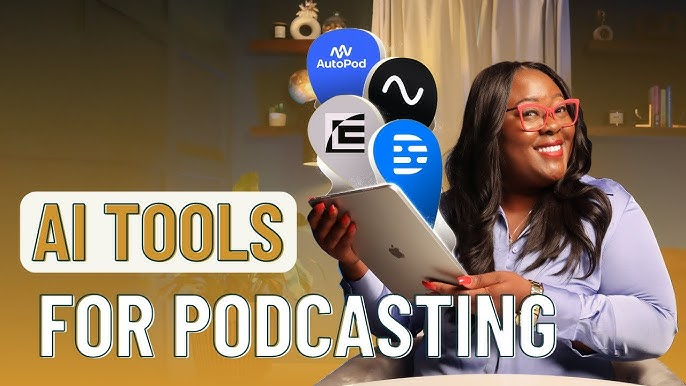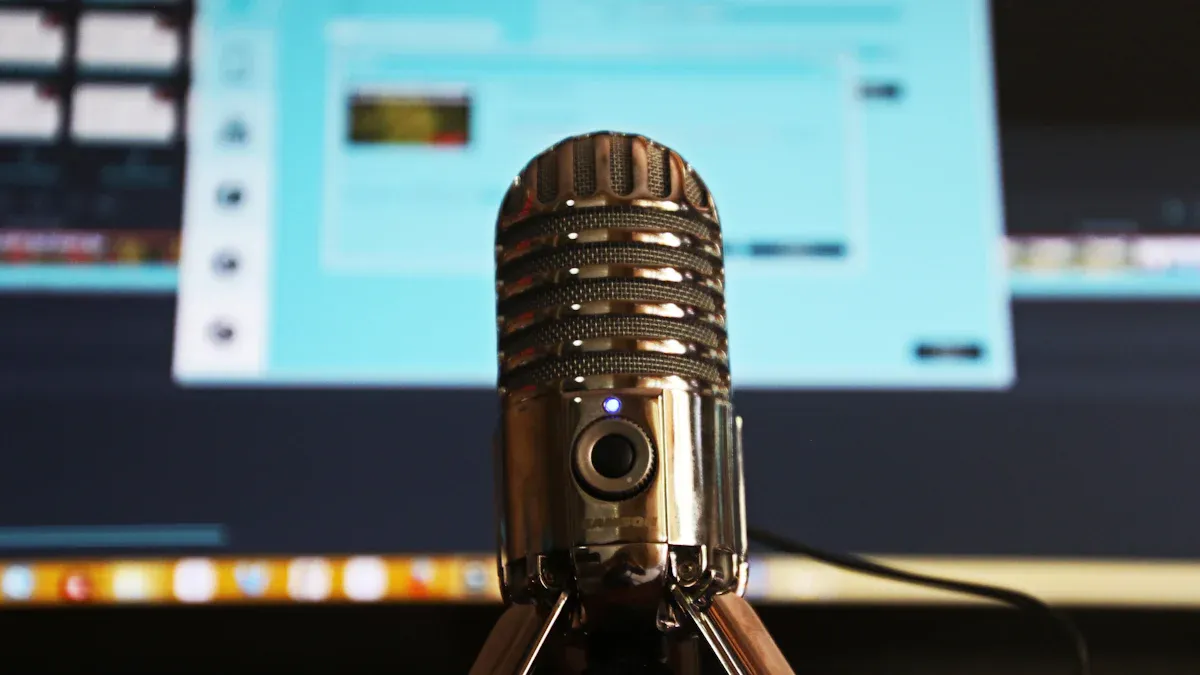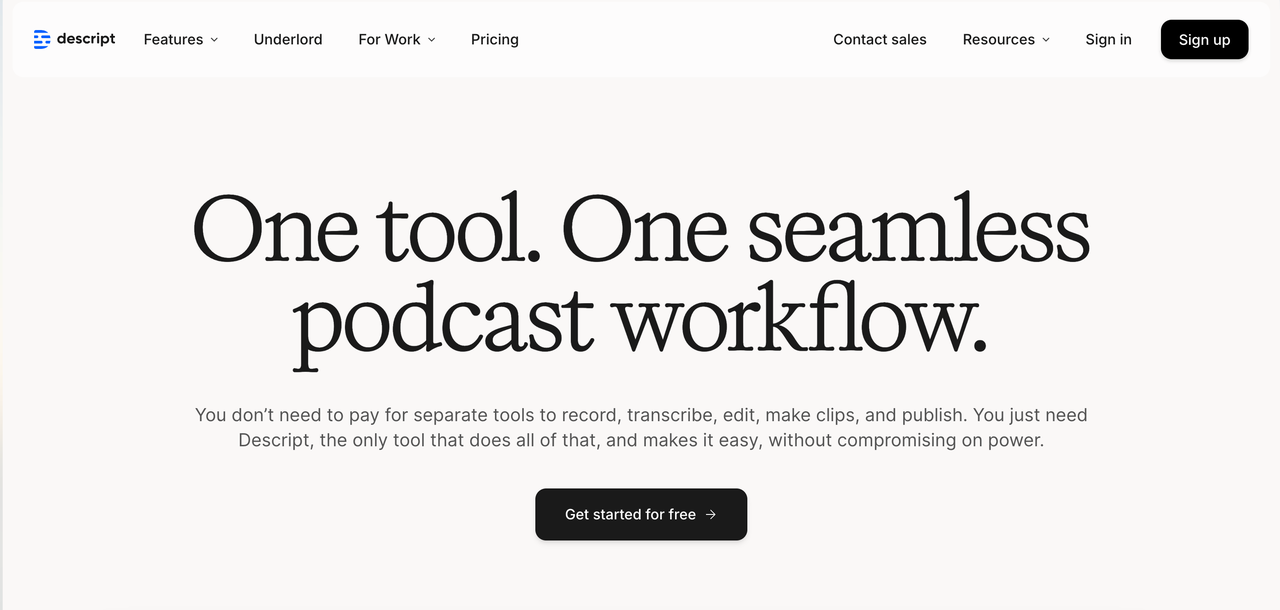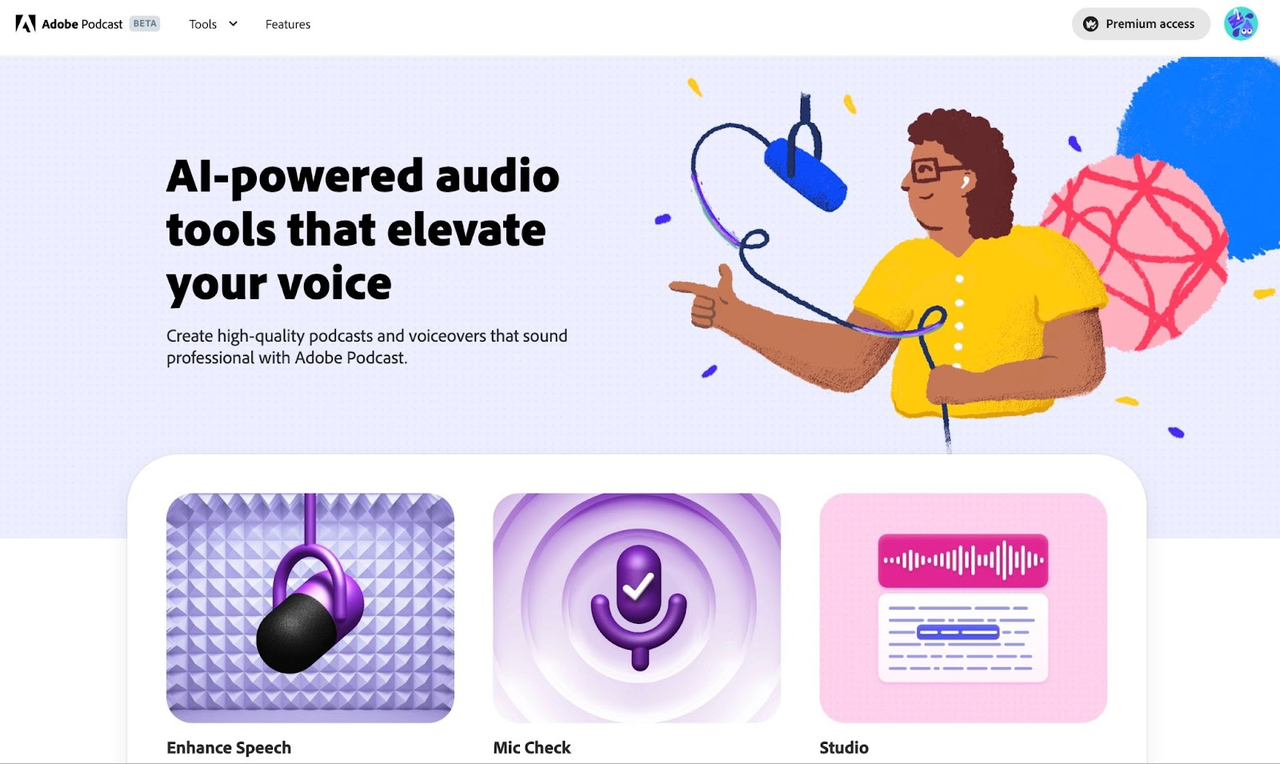How To Improve Audio Quality With AI for Your Podcast and 8 AI Tools Recommended

Good audio is key for a great podcast. An AI audio enhancer makes sound better and easier to fix. It cuts out background noise, makes voices clearer, and keeps volume steady. These tools help balance sound so every part is easy to hear. With AI, even new users can get pro-level audio without hard setups. You can save time and work on fun ideas while the tech does the hard stuff.
Key Takeaways
- Good sound quality is important for a great podcast. AI tools can make sound clearer and remove background noise.
- AI can cut out filler words and long pauses. This makes your podcast flow better and keeps listeners interested.
- Keeping sound levels steady is key. AI tools can balance the audio for a smooth listening experience.
- Using AI for editing saves time. It lets you focus on making awesome content by automating tasks like typing out words and removing noise.
- Try different AI tools to see what works best. Many tools have free trials so you can test them first.
How AI Audio Enhancers Improve Podcast Sound

Removes filler words and long pauses automatically
AI tools make editing easier by cutting out filler words like "um" and "uh." They also remove long pauses that interrupt your podcast's flow. These tools check your audio for extra pauses or repeated words. By fixing these, your podcast becomes smoother and more interesting to listen to.
For example, podcasters like Dann Williams use AI tools like CutMagic. This tool deletes awkward silences and filler words, saving lots of editing time. It makes podcasts sound polished and professional. This helps keep listeners interested and coming back for more.
🛠️ Pro Tip: Let an AI audio enhancer handle filler words. Focus on making great content instead.
Keeps audio levels steady
Having steady sound levels is important for a good podcast. AI tools are great at balancing audio so all parts have the same volume. This is helpful when you have different speakers or sections with uneven sound.
If audio levels are uneven, listeners might get annoyed and stop listening. AI tools fix this by adjusting sound levels automatically. For example, they keep levels between -20 and -16 LUFS, which is the standard for podcasts. They also prevent sudden loud or quiet parts, making the podcast flow better.
Here are tips for steady audio:
- Check sound levels while recording.
- Keep the waveform even to avoid loud or quiet spots.
- Use AI tools to balance sound during editing.
Balanced audio keeps your audience focused on what you’re saying.
Makes voices clearer and sharper
Clear voices are key for a good podcast. AI tools use smart tech to make speech clearer. They remove background noise, fix distortions, and improve voice quality. This makes your podcast sound professional.
For instance, tools like Descript's Studio Sound can tell the difference between voices and noise. They adjust to different noise levels, keeping voices clear even in noisy places. These tools also make voices sound better by reducing harsh or muffled sounds.
| Feature | What it Does |
|---|---|
| Noise reduction | Gets rid of background noise but keeps voices clear. |
| Level balancing | Makes sure volume stays the same throughout the podcast. |
| Voice enhancement | Improves how voices sound by removing harsh or muffled tones. |
Using an AI audio enhancer can turn bad recordings into great-sounding podcasts your audience will love.
Automating Editing Tasks to Save Time
Editing podcasts can take a long time. Doing it by hand is slow. AI tools make this easier by doing boring tasks for you. This lets you focus on making fun and interesting content. These tools handle jobs like typing out words, removing noise, and fixing sound levels. By using AI, you save time and energy.
For example, AI transcription tools turn hours of talking into text in minutes. You don’t have to listen and type everything yourself. Quick transcriptions help you post episodes on time. Posting regularly keeps your audience happy and loyal.
AI also makes editing faster by cutting out noise, fixing sound levels, and removing long silences. These tools make your work easier and faster. You can create great episodes without spending too much time editing. This gives you more time to tell stories and connect with listeners while AI handles the hard parts.
Here are some benefits of using AI for editing:
-
Faster Transcriptions: Quickly turn audio into text, saving lots of time.
-
Better Workflow: Spend less time on boring tasks and work faster.
-
Steady Quality: AI balances sound and makes voices clear for a pro feel.
Using an AI audio enhancer saves time and makes your podcast sound great. This lets you focus on making content your listeners will love.
Top 8 AI Tools for Podcast Audio Enhancement
Descript: Easy Editing Tool

Descript is a helpful tool for podcasters. It combines editing, transcription, and sound improvement in one place. You can remove pauses, fix sound levels, and edit audio by changing text. This makes it great for both new and experienced users.
One cool feature is its multi-track recording. You can record audio and video at the same time. This is perfect for podcasts with visuals. It also has text-to-speech, which turns written words into natural-sounding audio.
Here’s what Descript offers:
| Feature | What It Does |
|---|---|
| Text-to-Speech | Turns text into lifelike audio. |
| Recording Suite | Records audio and video together. |
| Smart Editing | Removes pauses and balances sound easily. |
| Sound Enhancement | Improves sound quality and reduces noise. |
| G2 Rating | 4.8/5 |
| Product Hunt Rating | 4.1/5 |
| Pricing (Essentials) | $14.99/month for 8 hours of video and 10 GB uploads. |
| Pricing (Pro) | $29.99/month for 20 hours of video and unlimited uploads. |
Descript makes podcasting easier by handling boring tasks. Its smart features save time and give professional results.
💡 Tip: Use Descript’s transcription tool to quickly make show notes or captions.
Adobe Podcast: Removes Background Noise

Adobe Podcast, once called Project Shasta, clears unwanted sounds. It removes background noise so your voice stands out. This is great for podcasters recording in noisy places.
It also has tools like auto-leveling and speech improvement. These features adjust sound to meet high standards. Your podcast will sound like it was made in a studio.
The interface is simple to use. Upload your audio, enhance it, and export the final version quickly. Adobe Podcast is perfect for podcasters who want great sound without much effort.
🎙️ Pro Tip: Pair Adobe Podcast with a good microphone for top-notch audio.
Auphonic: Automatic Editing Help
Auphonic focuses on making editing easy. It uses AI to improve sound by reducing noise, balancing volume, and fixing audio quality. This makes your podcast sound polished and consistent.
It can handle multiple tracks at once. This is useful for podcasts with many speakers or complex setups. Auphonic works with many file types, so it fits most recording tools.
There are free and paid plans. The free plan gives two hours of editing per month. Paid plans offer more features and higher limits.
🔧 Note: Auphonic’s batch editing saves time, especially for long episodes.
Podcastle: Easy Recording and Editing
Podcastle is a simple tool for recording and editing podcasts. It lets you record and edit audio right in your browser. You don’t need to install complicated software. You can also invite guests to join recordings from anywhere. This makes it great for interviews or co-hosted shows.
One cool feature is the Magic Dust tool. This AI-powered tool removes background noise and makes voices clearer. Even in noisy places, your podcast will sound professional. Podcastle also has multi-track editing. You can edit each speaker’s audio separately for better control.
It also offers text-to-speech and transcription tools. These help you quickly make show notes or captions. The platform is easy for beginners but has advanced features for experts.
💡 Tip: Use Magic Dust to improve your audio with little effort.
Krisp: Removes Noise in Real-Time
Krisp is a tool that cancels noise while you record. It uses AI to remove background sounds during live calls or recordings. Your voice stays clear, even in noisy places like cafés or busy homes. This makes your podcast sound professional.
Krisp is tested with NISQA, which checks sound quality. It measures noisiness, loudness, and clarity. Tests show Krisp removes up to 95% of background noise. This makes it one of the best tools for clear audio.
It’s easy to use and works with popular recording apps. Just click to turn it on, and it works instantly. You don’t need extra editing later. This saves time and keeps your audio quality high.
🎙️ Pro Tip: Use Krisp with a good mic for the best sound.
CreateWise AI: Smart Podcast Editor

CreateWise AI is a tool that makes editing podcasts faster. It handles boring tasks so you can focus on fun content. With one click, it removes filler words, long pauses, and fixes sound levels.
It also creates show notes and transcripts automatically. This saves time and helps more people enjoy your podcast. CreateWise AI can even make short clips for social media. This helps you share your episodes on Instagram or Twitter.
The platform is easy to use for beginners and pros. It helps you make professional podcasts up to 10 times faster. Check out CreateWise AI to see how it can improve your workflow.
🚀 Note: CreateWise AI combines many tools in one place, making podcasting easier.
Sonible smart:EQ: Smart Audio Equalizer
Sonible smart:EQ is a tool that improves sound using AI. It checks your audio and adjusts it for better quality. This makes your podcast sound clear and professional. If your audio has uneven tones, it fixes them easily. The tool suggests EQ changes that fit your needs.
A great feature is its ability to adjust for instruments. If your podcast has music or effects, it balances the sound. It also uses spectrum mixing to fix entire tracks. This is helpful for podcasts with many speakers or complex audio setups.
Here’s what smart:EQ offers:
| Feature | What It Does |
|---|---|
| AI Algorithms | Fixes sound issues and balances tones automatically. |
| Spectrum Mixing Techniques | Adjusts full tracks for better sound, great for music or effects. |
| Instrument Profiles | Matches EQ settings to different instruments for clear audio. |
| Hierarchical Control | Balances sound across multiple tracks for a polished result. |
Sonible smart:EQ saves time by handling EQ settings for you. Instead of doing it yourself, let the AI do the work. It’s perfect for podcasters who want great sound without extra effort.
🎧 Tip: Use smart:EQ to fix sound problems and improve tone balance.
iZotope RX: Fix Audio Problems Fast
iZotope RX is a top tool for fixing bad audio. It helps with noise, distortion, and missing sounds. Podcasters and sound experts love it for its easy fixes. It makes your audio clear and high-quality.
One cool feature is real-time noise removal. It cuts out unwanted sounds while you record. The Repair Assistant tool makes fixing audio simple. It checks your audio and fixes problems using AI. You don’t need to be an expert to get great results.
Here’s what iZotope RX can do:
| Feature | What It Does |
|---|---|
| Real-Time Noise Reduction | Removes noise instantly while recording for clear sound. |
| Repair Assistant | Uses AI to find and fix common audio problems fast. |
| Spectral Recovery | Brings back high sounds lost during recording for richer audio. |
| Interharmonic Editing | Fixes overlapping sounds for better clarity. |
| Instant Process | Speeds up editing by applying fixes right away. |
iZotope RX also restores high sounds lost in bad recordings. This is great for podcasters working in noisy places. It keeps your audio rich and full.
🛠️ Pro Tip: Use iZotope RX’s Repair Assistant to fix audio fast and save editing time.
Alternatives to AI for Podcast Audio Quality
Editing Audio by Hand with Pro Software
If you like full control, try editing by hand. Tools like Audacity, GarageBand, or Adobe Audition let you adjust sound details. You can fix volume, remove noise, and add effects. This takes time but gives you creative freedom.
Editing by hand also teaches you about sound production. You’ll learn to spot and fix problems like uneven sound. It’s slower than using AI tools, but you can make it match your style. Beginners can start with free tools like Audacity to save money.
🎧 Tip: Use headphones to hear small sound problems speakers might miss.
Hiring Sound Experts for Better Quality
Hiring a sound expert can make your podcast sound pro. These experts know how to mix, master, and design sound. They make your podcast polished and fun to hear.
Here’s a quick look at AI tools vs. hiring experts:
| Benefits of AI Tools | Drawbacks of AI Tools |
|---|---|
| Saves time and money on tasks | Misses emotional details and creative touches |
| Easy to use anytime | May not handle pacing or tone perfectly |
| Offers features like auto transcription | Limits creative control and custom options |
AI tools are fast and cheap but miss small details. Experts can fix these and make your podcast unique. If you can afford it, hire them for special episodes or big projects.
💡 Note: Use both AI tools and experts for the best results.
Buying Good Recording Gear
Good gear helps you record clear, pro-level sound. A quality mic cuts noise and makes voices sharp. The Elgato Wave Mic Arm LP is a strong, adjustable mic stand. It works with many mics and stays steady while recording.
For studio-quality sound, try the Rodecaster Duo. It has great XLR inputs and records multiple tracks. It also connects to Bluetooth for remote recording or extra devices.
Good gear improves sound and saves editing time. With fewer problems, you can focus on making great content.
🎙️ Pro Tip: Use a pop filter with your mic to reduce harsh sounds and improve voice clarity.
Improving Recording Environments
Making a good recording space is important for clear podcast audio. A well-set-up area reduces noise and makes your voice sound better. Follow these simple tips to improve your recording setup:
- Pick a Quiet Room: Choose a place with little outside noise. Turn off things like fans or fridges that make background sounds. A quiet room helps listeners focus on your podcast.
- Stop Echoes and Reverb: Hard surfaces can make sounds bounce around. Use items like foam panels, rugs, or curtains to absorb sound. This makes your podcast easier to listen to.
- Improve Room Sound: A room with soft furniture like couches or rugs can reduce noise. If you don’t have soundproofing, small rooms with soft items work well to stop echoes.
🎙️ Pro Tip: Put a thick blanket over hard surfaces to quickly reduce echo.
- Place Your Microphone Right: Keep the mic 6–12 inches from your mouth. This avoids harsh sounds like "p" or "b" and keeps the sound steady. A pop filter can also help make your voice clearer.
- Check Before Recording: Always test your setup before starting. Listen for any unwanted noise and fix it. Adjust your space to get the best sound.
By setting up your recording space well, your podcast will sound professional. A little effort now can make your podcast more enjoyable for listeners.
AI audio enhancers have changed how podcasts are made. They clean up sound, make voices sharper, and fix poor audio. These tools use smart technology to make editing faster and easier. They save time and help your podcast sound professional. Many popular podcasts use AI tools to improve quality and attract more listeners.
You can also try other options, like editing by hand or hiring experts. These methods give you more control and add a personal touch. By mixing AI tools with these strategies, you can create podcasts that sound amazing and keep your audience hooked.
🎙️ Tip: Use AI tools and record in a quiet space for great results.
FAQ
What is an AI audio enhancer, and how does it work?
An AI audio enhancer makes sound better using smart technology. It reduces noise, balances volume, and clears up voices. It checks your audio while recording or editing and fixes it automatically. This helps your podcast sound professional without needing special skills.
Do I need expensive equipment if I use AI tools?
No, AI tools work well with simple gear. But using a good mic and recording in a quiet room improves results. AI improves what you record, so starting with clear audio helps it work better.
Can AI tools replace manual editing completely?
AI tools do boring tasks like removing noise and fixing volume. They save time but can’t replace creative editing. Using both AI and manual edits gives the best results for a polished podcast.
Are AI tools suitable for beginners?
Yes, most AI tools are easy to use. They make hard tasks like editing and improving sound simple. Many tools have user-friendly designs, so anyone can make great podcasts without experience.
How do I choose the right AI tool for my podcast?
Think about what you need. Descript is good for all-in-one editing. Krisp is great for cutting noise. CreateWise AI helps with tasks like removing filler words and making show notes. Try free versions to see which one works best for you.